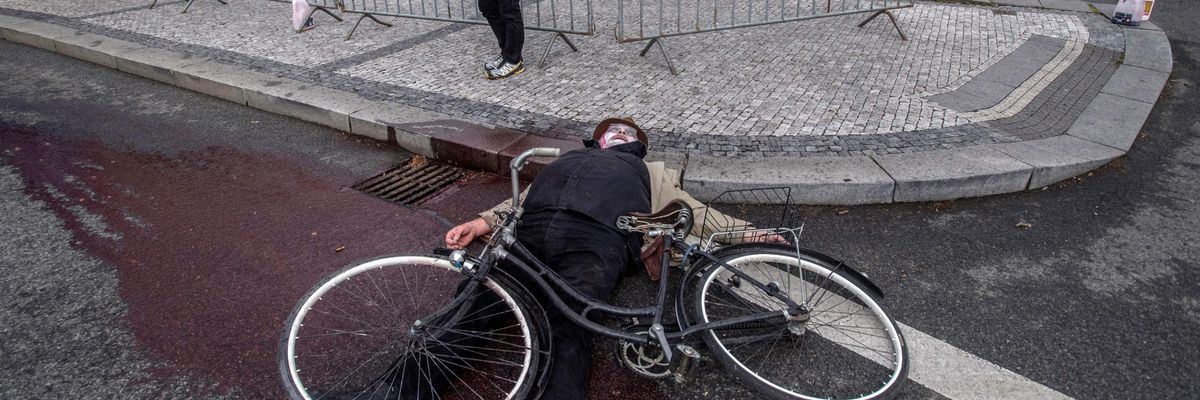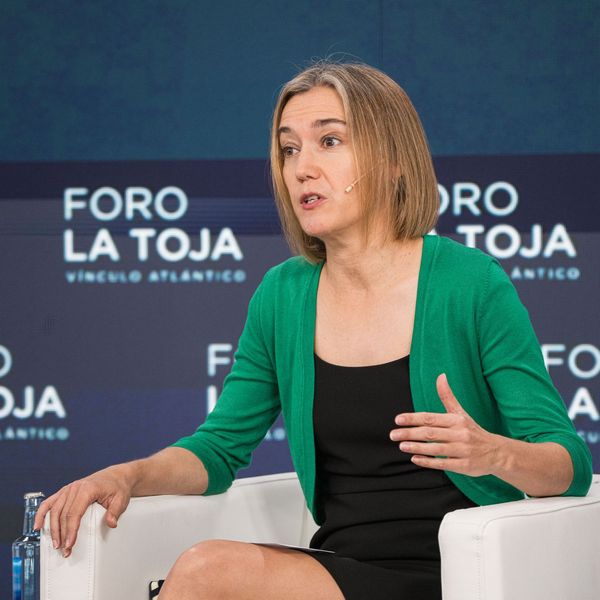
A demonstrator in front of the Russian Embassy in Prague replicates a real civilian killing in Bucha to protest Russian atrocities against civilians across Ukraine. Photo by Michal Cizek / AFP via Getty Images
Russia's Fake News: A Flagrantly Brutal Provocation
Faced with horrific evidence of their atrocities in Ukraine - cities razed, millions in exile, tens of thousands of dead civilians - Russia's state-run media has spun a ghastly, fetid fantasy to tell its own people: Nothing to see here. Over and over, on huge screens, TV hosts declare the bodies in the streets are fake news, Western agitprop, crisis actors playing a part, or victims of Ukrainian "Nazis." The world fights back with protests, sanctions, music, vital facts. Those same grim images, war crimes experts have testified, show "definite signs of death."
Facts, even when gruesome, remain the most potent weapon against malignant fiction. Following the massacre in Bucha, the New York Times published a map locating and identifying the bodies found there. It speaks grim volumes: "Man who went out for bread. Six dead in home for seniors. Woman killed in garden. Mother shot next to daughter. Boy found in basement. Family of four. Son shot next to father. Sisters killed in home. Man covered in dirt. Man and woman in concrete pit. Four bodies in street. Man shot in head..."
An Urgent Message From Our Co-Founder
Dear Common Dreams reader, The U.S. is on a fast track to authoritarianism like nothing I've ever seen. Meanwhile, corporate news outlets are utterly capitulating to Trump, twisting their coverage to avoid drawing his ire while lining up to stuff cash in his pockets. That's why I believe that Common Dreams is doing the best and most consequential reporting that we've ever done. Our small but mighty team is a progressive reporting powerhouse, covering the news every day that the corporate media never will. Our mission has always been simple: To inform. To inspire. And to ignite change for the common good. Now here's the key piece that I want all our readers to understand: None of this would be possible without your financial support. That's not just some fundraising cliche. It's the absolute and literal truth. We don't accept corporate advertising and never will. We don't have a paywall because we don't think people should be blocked from critical news based on their ability to pay. Everything we do is funded by the donations of readers like you. Will you donate now to help power the nonprofit, independent reporting of Common Dreams? Thank you for being a vital member of our community. Together, we can keep independent journalism alive when it’s needed most. - Craig Brown, Co-founder |
Facts, even when gruesome, remain the most potent weapon against malignant fiction. Following the massacre in Bucha, the New York Times published a map locating and identifying the bodies found there. It speaks grim volumes: "Man who went out for bread. Six dead in home for seniors. Woman killed in garden. Mother shot next to daughter. Boy found in basement. Family of four. Son shot next to father. Sisters killed in home. Man covered in dirt. Man and woman in concrete pit. Four bodies in street. Man shot in head..."
Facts, even when gruesome, remain the most potent weapon against malignant fiction. Following the massacre in Bucha, the New York Times published a map locating and identifying the bodies found there. It speaks grim volumes: "Man who went out for bread. Six dead in home for seniors. Woman killed in garden. Mother shot next to daughter. Boy found in basement. Family of four. Son shot next to father. Sisters killed in home. Man covered in dirt. Man and woman in concrete pit. Four bodies in street. Man shot in head..."
